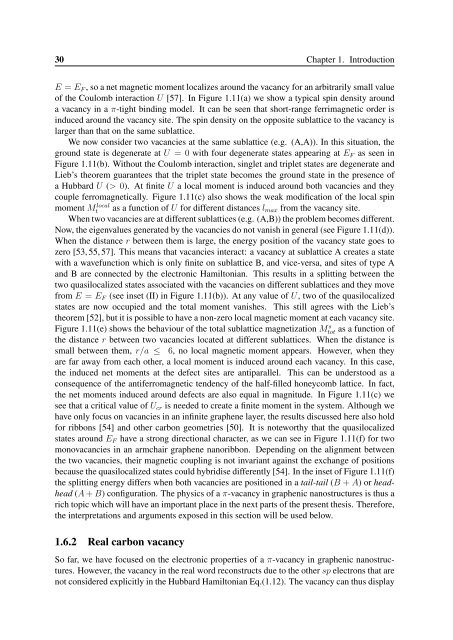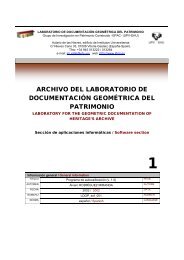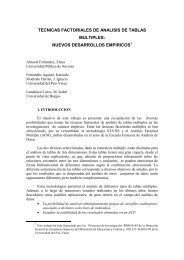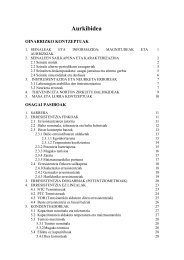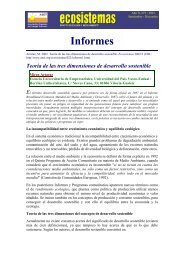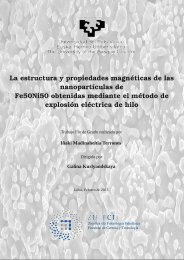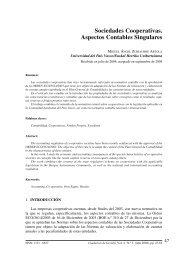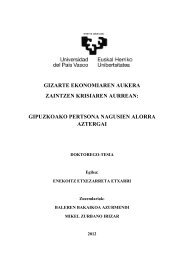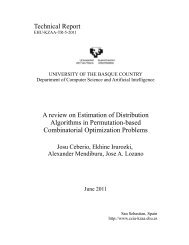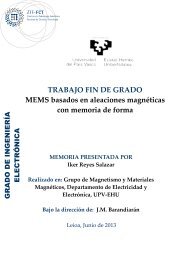Ï - ADDI
Ï - ADDI
Ï - ADDI
- No tags were found...
Create successful ePaper yourself
Turn your PDF publications into a flip-book with our unique Google optimized e-Paper software.
30 Chapter 1. IntroductionE = E F , so a net magnetic moment localizes around the vacancy for an arbitrarily small valueof the Coulomb interaction U [57]. In Figure 1.11(a) we show a typical spin density arounda vacancy in a π-tight binding model. It can be seen that short-range ferrimagnetic order isinduced around the vacancy site. The spin density on the opposite sublattice to the vacancy islarger than that on the same sublattice.We now consider two vacancies at the same sublattice (e.g. (A,A)). In this situation, theground state is degenerate at U = 0 with four degenerate states appearing at E F as seen inFigure 1.11(b). Without the Coulomb interaction, singlet and triplet states are degenerate andLieb’s theorem guarantees that the triplet state becomes the ground state in the presence ofa Hubbard U (> 0). At finite U a local moment is induced around both vacancies and theycouple ferromagnetically. Figure 1.11(c) also shows the weak modification of the local spinmoment Mtlocal as a function of U for different distances l max from the vacancy site.When two vacancies are at different sublattices (e.g. (A,B)) the problem becomes different.Now, the eigenvalues generated by the vacancies do not vanish in general (see Figure 1.11(d)).When the distance r between them is large, the energy position of the vacancy state goes tozero [53, 55, 57]. This means that vacancies interact: a vacancy at sublattice A creates a statewith a wavefunction which is only finite on sublattice B, and vice-versa, and sites of type Aand B are connected by the electronic Hamiltonian. This results in a splitting between thetwo quasilocalized states associated with the vacancies on different sublattices and they movefrom E = E F (see inset (II) in Figure 1.11(b)). At any value of U, two of the quasilocalizedstates are now occupied and the total moment vanishes. This still agrees with the Lieb’stheorem [52], but it is possible to have a non-zero local magnetic moment at each vacancy site.Figure 1.11(e) shows the behaviour of the total sublattice magnetization Mtot s as a function ofthe distance r between two vacancies located at different sublattices. When the distance issmall between them, r/a ≤ 6, no local magnetic moment appears. However, when theyare far away from each other, a local moment is induced around each vacancy. In this case,the induced net moments at the defect sites are antiparallel. This can be understood as aconsequence of the antiferromagnetic tendency of the half-filled honeycomb lattice. In fact,the net moments induced around defects are also equal in magnitude. In Figure 1.11(c) wesee that a critical value of U cr is needed to create a finite moment in the system. Although wehave only focus on vacancies in an infinite graphene layer, the results discussed here also holdfor ribbons [54] and other carbon geometries [50]. It is noteworthy that the quasilocalizedstates around E F have a strong directional character, as we can see in Figure 1.11(f) for twomonovacancies in an armchair graphene nanoribbon. Depending on the alignment betweenthe two vacancies, their magnetic coupling is not invariant against the exchange of positionsbecause the quasilocalized states could hybridise differently [54]. In the inset of Figure 1.11(f)the splitting energy differs when both vacancies are positioned in a tail-tail (B + A) or headhead(A + B) configuration. The physics of a π-vacancy in graphenic nanostructures is thus arich topic which will have an important place in the next parts of the present thesis. Therefore,the interpretations and arguments exposed in this section will be used below.1.6.2 Real carbon vacancySo far, we have focused on the electronic properties of a π-vacancy in graphenic nanostructures.However, the vacancy in the real word reconstructs due to the other sp electrons that arenot considered explicitly in the Hubbard Hamiltonian Eq.(1.12). The vacancy can thus display


